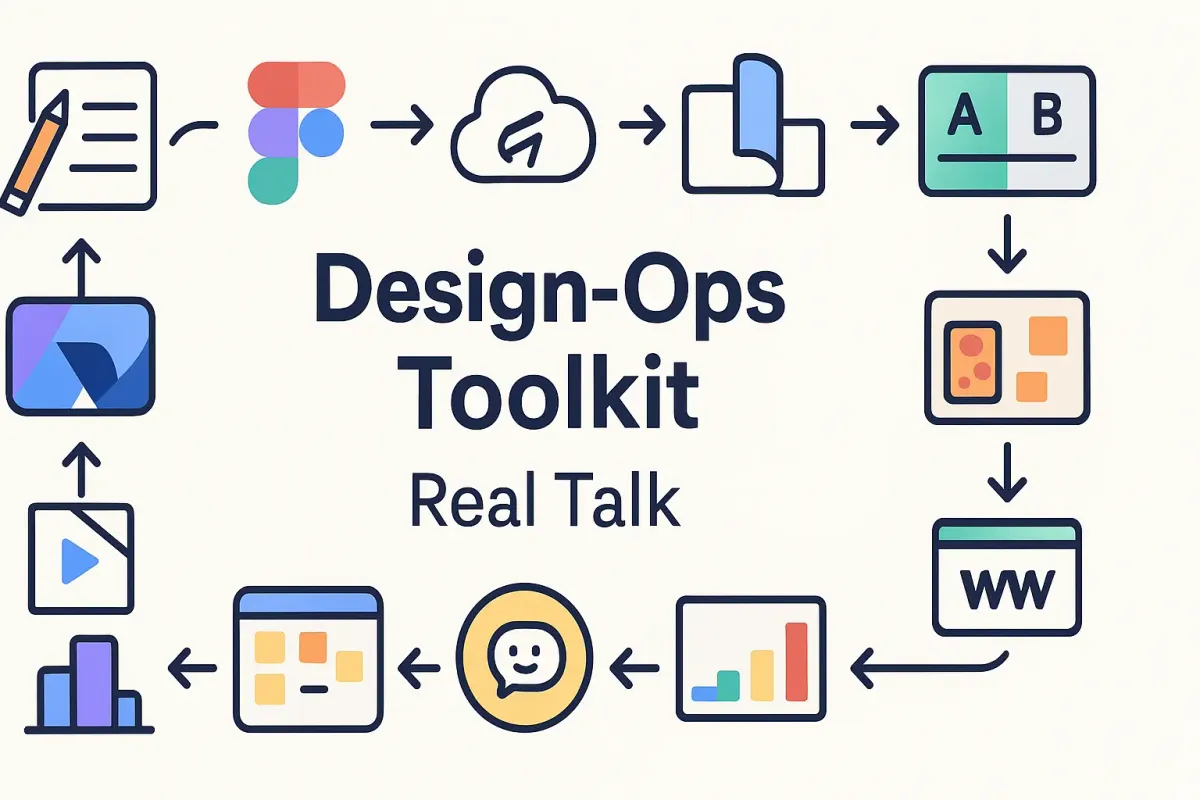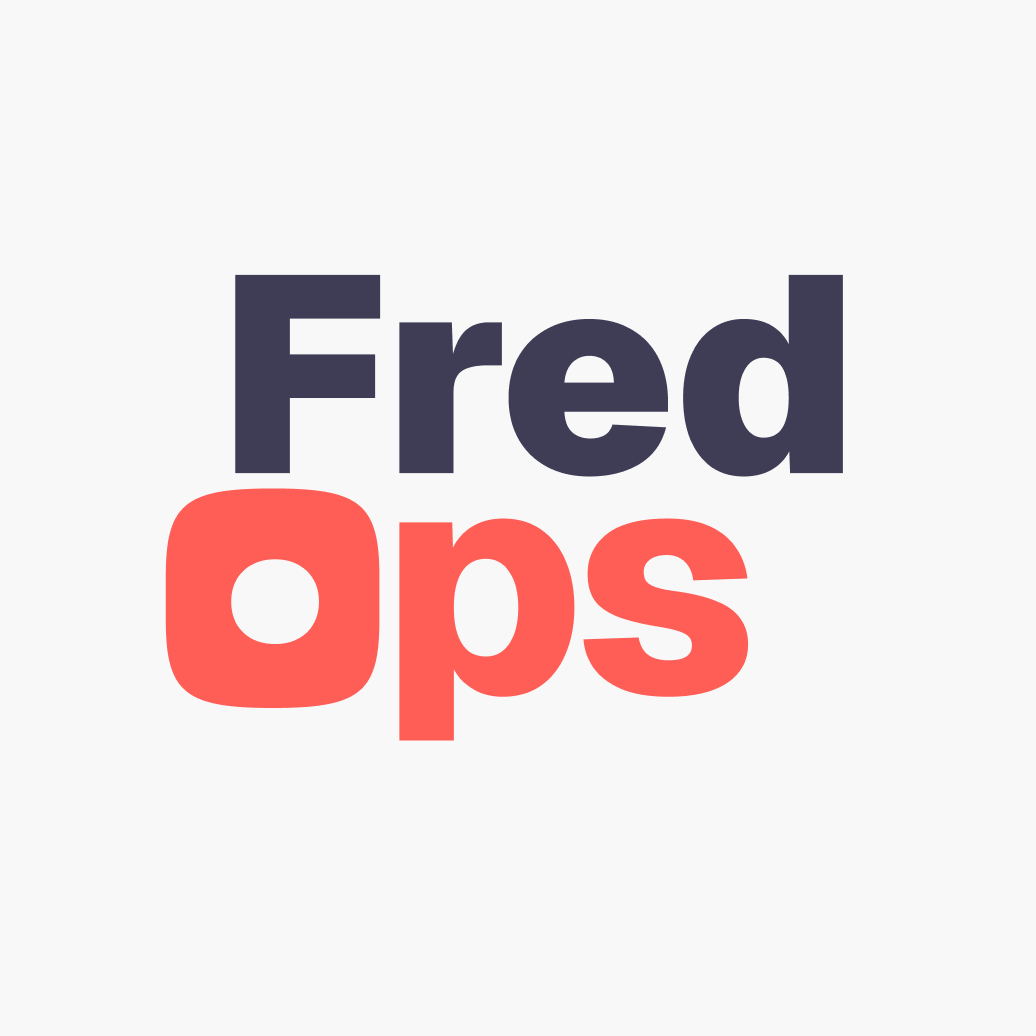Tools We Rely On Daily for Design-Ops Success

An honest breakdown of the 13 tools that power our iterative product-design workflow and the hard-earned lessons that keep our design operations evolving.
The Real Talk About Design Ops Tools
I've tested quite many tools already - around 30, I'd say, or even more. There are a lot of tools out there, but the reason why you want to use them is because they help you build up your speed of delivering design and make it more adequate. Through this exploration of tools, we've only kept those that are working best in their context and save us enough time.
Basically, everything could be done with Paint or some other basic graphic design tool. Pretty much everything - well, not everything, but it's not sensible. The way I think about it is to see the best time cuts and conversion increases in our designs and for our clients. That's basically how I feel about it and how I choose tools for design ops.
If we come to any sort of challenge, something that I see that I cannot do effectively, then I try to see if there are other options and check the tools that could be used for making it work faster and better. I try to use those tools and observe whether they are a fit and whether they indeed increase our way of working. If we benefit from simply having them, then I visualize our flows and think about where we can put them in our design ops process.
Our Design Ops Loop in Practice
Here's what we're left with now and how these tools fit into our design operations:
- Discover pain points with interviews and analytics
- Ideate rapidly, sketching widely before we narrow
- Prototype & animate flows for early critique
- Validate with live data and split tests
- Build & launch in sprints
- Learn through kpi's and retrospectives
Each stage maps to at least one of our core tools. Let me break down exactly how.
The 13 Tools That Actually Matter in Design Ops
Pen and Paper
This helps us basically quickly iterate, validate ideas, draw something, and visualize it to stakeholders. Fast, human, distraction-free. Every ideation session in our design ops starts here—loose user flows or radical UI twists sketched in 90 seconds.
Excalidraw
Next thing behind pen and paper is Excalidraw, which is an excellent tool for making pen-and-paper-style drawings and visualizations on the board that we can share with clients online. Basically, first we go with pen and paper, but if we need to do it remotely, then I opt for Excalidraw. Hand-drawn feel, digital speed—we drop Excalidraw frames into our design ops workflow to present explorations that feel approachable during critiques.
Figma
Figma is a tool that we use to make nice designs and prototypes, and we really like to cooperate with FigJam. We use Figma for any high-fidelity or low-fidelity designs, big design systems, or big chunks of components that need to be up to date and using the same design system. It's an excellent tool for that, especially for high fidelity and organization of all the work. Pages help with it too.
Cloud-native collaboration makes Figma our design source of truth in our design ops. From wireframes to polished prototypes, shared libraries sync with our project management. FigJam sessions replace what once took half a dozen whiteboards.
Mobbin
We use Mobbin for inspiration, for UI research and inspiration. Basically, we can clearly see quickly different flows of applications, how they were done, and try based on that to generate ideas and think about the best user experience and UI flows. Real-world UI research on demand—when blocked on interaction patterns, we jump to Mobbin, filter by industry, and pull inspiration straight into moodboards.
Framer
When we sell our services, we often use Framer, which gives us higher flexibility and a quicker option to make nice-looking landing pages with all the prototypes and animations in place. Motion-first prototyping without code. High-fidelity animations and micro-interactions come alive here, giving stakeholders a feel for timing and easing. It slotted into our design ops toolchain after pen-and-paper storyboards proved too static for usability tests.
But we don't really like Framer for making the webpages themselves, so we prioritize Webflow here.
Webflow
We really like Webflow as a tool that we can use to develop fully functional and nice pages for our clients without needing a developer on board. We can do some integrations there, make converting webpages, analyze them, and do some A/B optimization as well.
Visual development for real shipping. Once a Framer prototype passes validation in our design ops process, designers port key pages to Webflow for production-ready HTML/CSS—with devs focusing on complex business logic instead of pixel perfection.
Condens
For user research, we use Condens. Condens is very nice for color tagging and tagging the user interviews we do. This is a tool that helps us organize our research and then analyze it to make conclusions based on the research. All-in-one research repository that transcribes interview notes, tags insights, and links them back to project epics—closing the gap between discovery and delivery in our design ops.
Hotjar
We use Hotjar for observing session recordings of our users using applications we support. Heatmaps and session replays during our "Observation Fridays"—we watch five random replays to spot friction. Coupled with design comments, it turns subjective hunches into concrete pixel tweaks in our design ops workflow.
GA4 (Google Analytics 4)
We use GA4 quite extensively for seeing the funnels and also the sources of acquiring new clients. This is both for marketing purposes but also for design optimization—seeing drop-out rates and such. Event-driven product analytics with custom dimensions feed into our growth dashboard, surfacing engagement and drop-offs. Modeling events early paid off for funnel clarity in our design ops.
VWO
We use VWO when we want to do A/B tests. If there's any sort of need for A/B testing, this is the go-to tool. We like it for pricing and flexible business models. Experimentation at scale—we run no-code A/B tests and multivariate experiments here, integrating results back into GA4 so we see one consolidated truth in our design ops reporting.
Jira
We use Jira for tracking collaboration in design between stakeholders, managing design tasks, and reporting our progress. Backlog, sprints, and cross-team visibility. Epics link to design files and research insights. Dashboards show design debt alongside dev tasks, keeping conversations focused on throughput in our design ops.
During daily stand-ups, we look at Jira and analyze what we have there. Based on that, we create and interact with tasks and provide feedback.
ChatGPT and Generative AI Tools
We use quite a few generative AI tools for making the generation of ideas quick, for research, and also concept generating. We especially like working with OpenAI models. Basically, on a daily basis, we work with it quite regularly—this creates this process of handoff.
ChatGPT drafts UX microcopy, maps acceptance criteria, and proposes variant ideas for A/B tests. We also lean on generative AI image tools to create quick hero visuals for prototypes and web mockups. Guardrails: always human-review before anything ships in our design ops process.
Excalidraw in Workshops
We use Excalidraw at the beginning of workshop sessions with clients when working with ideas. This is quite strongly embedded in our design ops processes.
Our Design Ops tool Evolution Timeline
We shifted in 2022 from other tools (Axure RP) toward Figma, then added Excalidraw on top of it later. We added Jira and Google Analytics was with us from the beginning. We moved to VWO in 2024 from custom-made A/B testing solutions. We introduced Mobbin just a month ago. Condens we use extensively from 2023, and Framer and Webflow are quite strongly embedded in our workflow from 2024.
We also used some tools that we didn't adopt. Zeplin, for example—we learned that even though something looks nice (like developer mode in Figma), it doesn't seem to be used by the people we collaborate with. Quite often, better organization of things in our daily design work helps us much better than introducing new tools.
We thought that for handoff, which is very important from our point of view, Zeplin or some other tools might work better. But to be honest, working with Figma smartly and making a couple of organized source files seemed to deliver much better results in our design ops.
Design Ops Decision Framework
We vet newcomers in our design ops based on:
- Ease of onboarding
- License cost per seat
- API openness
- Ability to reduce cycle time by ≥15%
So basically, if we come to any sort of challenge, it's something that I see that I cannot do effectively, then I try to see if there are other options of going with it and check the tools that could be used for making it work faster and better. I try to use those tools and observe whether they are a fit and whether they indeed increase our way of working, and if we benefit from simply having them.
Hard-Earned Design Ops Lessons
Ruthless curation beats shiny-tool syndrome. Everything could be done with basic tools, but it's not sensible. The way I think about design ops is to see the best time cuts and conversion increases.
Integrations matter more than individual features. This creates the process of handoff that's so crucial in design ops.
Document ceremonies first - then choose software. We learned that better organization of things in our daily design work helps much better than introducing new tools.
Quarterly audits prevent bloat. We're constantly evaluating whether tools indeed increase our way of working.
Generative AI tools excel at iteration but require clear prompts and human QA. We work with AI quite regularly on a daily basis, but always with human oversight.
Why This Design Ops Stack Works
Basically, why we use Framer and Figma together: Framer is very good for animations that Figma can do with some workarounds, and Framer can help us put out a live webpage. Now we also have Figma webpages, but some time ago it wasn't available, so it was very helpful.
Webflow is very good when we don't need custom software development—when we can do just beautiful webpages for our clients. This separation allows our design ops to flow smoothly from concept to delivery.
The Bottom Line on Design Ops Tools
That's the living toolkit behind our design ops engine—thirteen tools, one cohesive loop. Through this exploration and testing of around 30 tools, we've only kept those that are working best in their context and save us enough time.
The key is observing whether they are a fit and whether they indeed increase your way of working. If you benefit from simply having them, then visualize your flows and think about where you can put them in your design ops process.
Everything in design ops could be done with basic tools, but it's not sensible. The way to think about it is to see the best time cuts and conversion increases in your designs and for your clients. That's how you build a design ops foundation that actually works.
